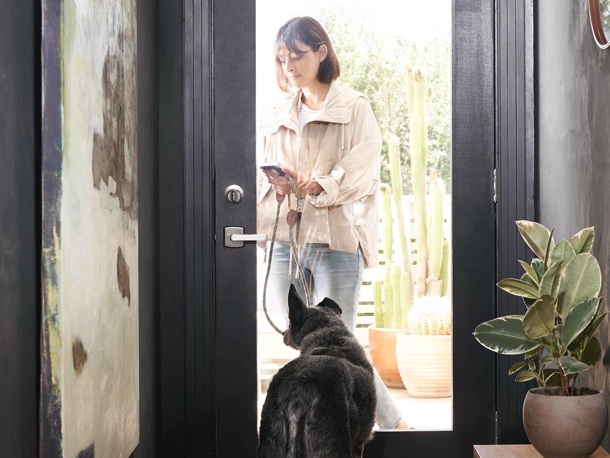Published August 28th, 2024
Written by Level Home Staff
A guilt-free guide to leaving your dog home alone
5 minute read
If you find yourself asking “Can I leave my dog home alone while at work?” you’ve come to the right place; it can be done. Generally, the preparation for leaving your dog(s) home alone depends on their age, health, and personality. While your own furry friend (or friends!) may involve additional training, planning, or professional intervention, this guide will help you as you prepare for a big step in dog ownership.
How to start leaving your dog home alone
Remember, some dogs may have unique concerns that require help from a professional behavioral specialist or veterinarian. If your dog is showing signs of serious separation anxiety, it’s best to consult with your veterinarian.
1. Start slowly and work your dog up to longer periods of alone time
Suddenly expecting your dog to handle a full workday alone can be overwhelming for them and likely won't go smoothly. To ease them into being alone, start with shorter periods and gradually increase the duration until it matches the time they'll usually be left alone.
Begin by leaving your dog for a brief period to gauge their comfort level—some dogs might handle an hour well, while others may need to start with just 5 or 10 minutes. Consider setting up cameras to monitor how they behave while you're away.
When you return, if your dog has behaved well, reward them with a treat, attention, or whatever they find motivating. If not, take note of any issues—did they bark excessively, leading to complaints from neighbors? Did they damage furniture or get into the trash? This information will help you plan for the next time or signal that it might be time to seek professional help.
Note: If you’re concerned about their safety while you’re out of the house, remember a crate can be a helpful training tool to keep them out of trouble! Just remember, “If you do notice distress, it is important to consult with your veterinarian immediately. A customized treatment plan can be designed to address your dog’s emotional needs. Avoid leaving your dog alone until she can be treated. You may need to hire a pet sitter for the short term.” - VCA Animal Hospital
2. Dog-proof your home
Set your dog up for success by removing any potential hazards from their environment before you leave. For instance, if the trash is irresistible to your dog, consider using a lidded can they can’t open or place the bin in a room they can’t access. If they tend to bark at people passing by, close the shades or curtains to block their view. Ensure that cleaning supplies and toxic houseplants are out of reach.
Utilize gates and doors to keep your dog out of trouble. For example, if you're worried about them chewing on computer cables, close your office door while you're away, or if a door isn’t available, use a gate to block off the area.
“It is important that you never punish your dog if you come home to damage or if your dog has soiled. Just clean quietly, ideally with your dog out of the area.” - VCA Animal Hospital
3. Make sure your dog gets plenty of exercise and enrichment
A dog with excess energy is more likely to become stressed, bored, destructive, or otherwise misbehave when left alone. To help them stay calm, ensure they get plenty of exercise throughout the day through walks, playtime with other dogs, or interactive games with you. Enrichment toys and activities, such as training sessions or puzzle toys, can also help tire them out and keep them occupied.
4. Build a routine with your dog so they know what to expect
Routines aren’t just for humans—dogs thrive on them too! Establishing a consistent schedule helps your dog know when to expect exercise, meals, and your comings and goings. When your dog knows what to expect and when, it can reduce their stress and help them feel more secure.
5. Take them out before you leave
Your dog’s age affects how long they can go between potty breaks, so it’s important to consider this when planning your time away. To prevent accidents and keep your dog comfortable while you're gone, always make sure to take them out before you leave.
6. Hire a dog walker to pop in while you’re away
Depending on your dog’s needs, they may require more frequent potty breaks, or you might want to ensure they get exercise, socialization, and outdoor time during your 9-to-5 workday. Services like Wag! allow you to easily hire a dog walker who can take your pup out for a walk, to the dog park, or wherever is best for them. If you have a smart lock with a keypad, you can conveniently grant the dog walker access with a unique code. Plus, you can monitor when they arrive and leave, giving you peace of mind that your dog is well taken care of.

7 Tips for leaving your dog home alone while at work
1. Do not make leaving and coming home a big deal
While it's important not to ignore your dog, avoid making your comings and goings a big event. Stay calm when you leave and resist the urge to immediately greet your dog upon returning. Instead, wait until they’ve settled down before giving them attention. This approach helps your dog see your departures as routine, reducing their stress and setting them up for success.
2. Don’t leave out small toys
Small toys can be hazardous for unsupervised dogs, as they pose a choking risk or could be swallowed, potentially leading to a life-threatening blockage. If your dog tends to tear apart stuffed toys, it's wise to keep them out of reach while you're away since the stuffing and squeakers can be equally dangerous. Instead, opt for safer options like Nylabones or antlers that are appropriately sized and suited to your dog's chewing habits.
3. If you crate your dog, get them used to it first
Don’t expect your dog to immediately love their crate, and be mindful not to unintentionally make them fearful of it. Introduce your pup to the crate gradually, using positive reinforcement to create a positive association. Keep the crate accessible while you’re home to help them get accustomed to it. Also, remember to provide water and remove any small toys while they’re in the crate and you’re not home to ensure their safety.
4. Make use of pet cameras and smart locks
Don’t underestimate the power of smart home technology for improving pet care, and giving you peace of mind. Pet cameras can help you keep an eye on your dog or dogs while you’re away, some even have the option to speak to your pet through them. Smart locks simplify access for others who may be dropping in to care for your dog while you’re at work.
5. Establish a safe space for your dog
Designate a specific dog bed or area in your home as your dog’s “safe spot.” This will be their go-to place for comfort and relaxation. Use positive reinforcement, such as gentle praise and treats, to encourage your dog to calmly settle in their safe spot, helping them feel secure and at ease.
6. Consider doggy daycare
If you have a high-energy dog, try bringing them to a doggy daycare a few times a week. Even just one day a week can help your dog have a healthy outlet for their energy and establish a consistent routine.
7. Leave white noise playing
Before you leave, turn on the radio, a noise machine, or the TV to make your dog more comfortable. If you have a smart TV, there is a great selection of “dog TV” and 10-hour videos of calming music you can put on so they don’t time out while you’re away.
Frequently asked questions about leaving dogs home alone
How long can a dog be left alone?
As we mentioned above, how long a dog can be left home alone depends on the dog's age, health, and temperament. For healthy, well-behaved dogs, many people like to use the amount of time their dog can go between bathroom breaks as the amount of time they can be left alone. As a rule of thumb, the time dogs can go between bathroom breaks is:
Dogs <1 - 1.5 years: months to hours (3 months old = 3 hours) up to 6 hours
Dogs 1.5 - 10 years: 6 - 8 hours
Dogs >10 years: 4 - 6 hours
Where is the best place to leave your dog while at work?
Where you can leave your dog while you’re at work depends on your dog and your living situation. Some people let them have the roam of the house, while others opt for a crate. If you live with roommates, communicate with them to plan where you will safely leave your dog while you’re away.
Should I leave water out for my dog when I go to work?
Yes, your dog will need access to clean drinking water while you’re away at work. If your dog likes to paw in the water bowl, try buying a raised bowl to keep it off the ground.
Can I leave my dog in a crate while at work?
This depends on your dog, how long you will be away, and the training you’ve done with them.
Conclusion
With the right planning and training, you can safely leave your dog home alone while you’re at work.
